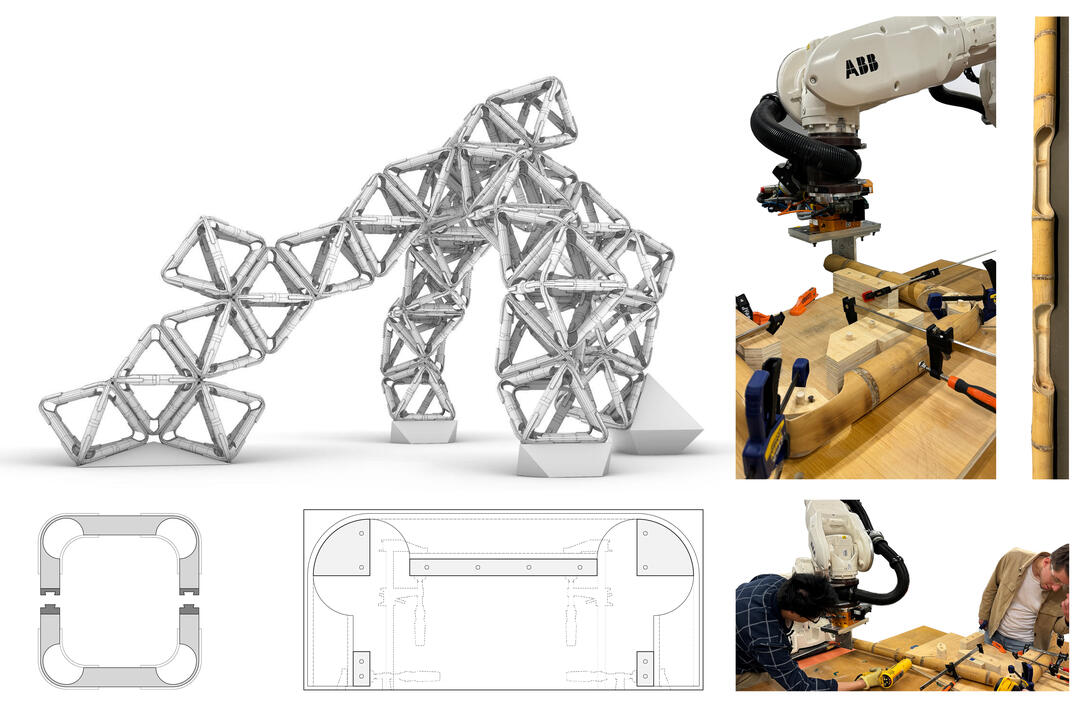PJ Dick Innovation Fund Teaching Grant: Bending Active Systems_ Bamboo Research Pavilion I Prototyping material and spanning systems in Bamboo_ using robotic arms and steam-bending

Bending Active Systems_ Bamboo Research Pavilion I Prototyping material and spanning systems in Bamboo_ using robotic arms and steam-bending
Vicky Achnani, Associate Studio Professor, Carnegie Mellon Architecture
Research Assistants: Vina Wei, Myles Sampson
Course offered Fall 2024 & Spring 2025
Bamboo, a material endowed with vast, yet largely untapped, potential – especially within the domain of architecture – serves as a testament to nature’s ingenuity. Despite its remarkable attributes, bamboo remains an underutilized resource in architectural practice, often relegated to peripheral applications such as scaffolding, and occasionally used in a more substantive capacity. As a rapidly growing, low-cost, carbon-sequestering natural resource, it offers tremendous promise that has yet to be fully realized. It is time to reassess our approach and unlock the full potential of this multifaceted material in the 21st century.
Predominantly cultivated in the developing regions of the Global South, bamboo has traditionally been processed using conventional methods. This versatile material is characterized by its exceptional combination of flexibility, stiffness and efficiency in material distribution, resulting in lightweight yet robust structural systems. Bamboo's inherent ability to withstand tensile stresses, buckling and bending, coupled with its remarkable elastic properties, makes it an ideal candidate for innovative architectural applications. Through material research, this course seeks to harness these attributes of bamboo to create spanning and spatial systems that leverage its intrinsic qualities.
Traditional uses of bamboo, such as whole culms, impose limitations on its spanning and bending capabilities and render it more susceptible to splitting. When properly bent, however, bamboo activates its tensile capacity, enabling more efficient distribution of material across structural systems. The integration of bamboo with digital fabrication techniques offers the opportunity to explore radically innovative and spatially adaptable configurations. While working with this irregular material presents challenges, it also holds the potential for groundbreaking outcomes. CNC routing provides a means for precise sectioning of bamboo culms, while the use of robotic arms for bending eliminates the need for custom jigs for each new bending profile.
This research endeavors to explore material systems that utilize variable cross-sections of bamboo culms along their length, allowing for more efficient spanning capabilities. The variation in cross-sectional profiles responds dynamically to specific positions, bending forces, loading conditions and the diverse roles of members within a broader spanning system. Through these innovative approaches, the research aims to unlock new possibilities for the application of bamboo in modern architectural design.
Image: A1 48626 Fall 2024_ Student's work ( Master Image).
About the Project Lead
Associate Studio Professor
-
Established in 2023 by PJ Dick Trumbull Lindy Group, the Faculty Grants Program will award a total of $400,000 over four years beginning in 2024. The program supports faculty research and teaching innovations that address the School’s three pedagogical challenges of climate change, social justice and artificial intelligence. The proposals were assessed on their impact in furthering a faculty member’s research and teaching, their contribution to interrogating the School’s challenges, and their viability to garner further research support, make an impact on the discipline and expand the pedagogy of the School.
